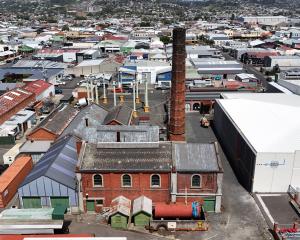By Jogai Bhatt
New Zealand's sandwich offerings haven't been the best, historically. For years, it was pre-made, cling-wrapped triangles of white bread with slices of processed ham and cheese in between. Maybe a slick of mayonnaise slapped on. The sandwich would be cold and a bit limp, having sat in a cafe's cabinet all morning, but it made do for a quick lunch.
Over the past few years, things have shifted. The humble sandwich has been elevated into a fulsome meal, with many cafes and delis around the country offering up super-sized, American-style XXL sandos - fluffy, freshly-baked bread packed to the brim with high-quality ingredients and condiments.
It's a simple offering in theory, but local sandwich makers say it takes a bit of mastering to get it right.
'Nobody wanted the groceries, everybody just wanted the sandwiches'
'The French' at Hokitika Sandwich Company is a hearty sandwich made of ham, brie, aioli, mustard and greens.
Joseph Walker was an early adopter of serving big, gourmet-style sandwiches. It all began in 2010, when the Wellington-born sandwich maker moved to Denver, Colorado in the US. For five years, he lived in what's called a 'food desert' - a low socio-economic area where access to healthy, affordable food is rare - and says he "fell into" making sandwiches there.
"As a Kiwi growing up, we never really went out and paid someone for a sandwich. It was always one of those things you just made at home and you brought with you to work or school ... I kind of fell into it naively.
"My buddy and I had taken over a little delicatessen, so we sold meats, cheeses, breads ... the staples. About a week before we opened, I was like, well, I'm selling everything for a sandwich, so why don't I just make a few fresh condiments in-house, some mustard and some fresh mayonnaise every morning, and we'll just have 10 to 20 sandwiches a day available for people who want them while they're shopping.
"Within about six months, we had lines out the door, and nobody wanted the groceries, everybody just wanted the sandwiches."
When he returned to New Zealand in 2015, Walker travelled around the country before settling in Hokitika. There, he saw an opportunity to do more in the local food scene, and just two years later, the first Hokitika Sandwich Company was open for business on the West Coast of the South Island. A second shop in Christchurch followed in 2017.
They boast menus of about nine fat sandwiches costing $23-$25 for a full (or $12-$13 for half) including the coaster (fried runny eggs, prosciutto, aged cheddar, west coast butter, aioli, black pepper and greens) and a stuffed seasonal veggie offering with sauerkraut, goat cheese, red onion, tomato pesto, aioli and greens. There's also a kids' build-your-own option for $8.
"You can almost close your eyes when you walk into a New Zealand cafe and order, you don't even need a menu - they'll have a sausage roll, a quiche, a pie, and it was really just missing this high-quality fresh sandwich. It's one of those classic food items that New Zealand's never done well ... I saw an opportunity and went for it."
Walker says super-sized sandos are definitely coming to New Zealand, if they're not here already.
"We're slowly seeing different layers come through. Twenty-odd years ago, you couldn't get sushi in New Zealand, US-style smoked meats wasn't something that was widely available even just five to eight years ago ... and now there's probably a dozen places doing it really well.
"New Zealand food culture has a lot of holes in it, but it just slowly comes through. I don't feel like it's necessarily a trend, I think New Zealand's just catching up."
'It's gotta have the right amount of everything'
At Gloria's deli in Auckland, two pillowy soft slabs of focaccia are slathered with pesto and honey, before ribbons of mortadella and creamy burrata are shoved in. The mammoth sandwich is then completed with a sprinkling of almonds for good measure. All five of the fresh focaccia sandwiches on the menu come at $18 for a full.
Owner and chef Nick Landsman says it's these quality ingredients, and how you make use of them, that make the difference between a good sandwich and an okay one - and how much you pay for them.
"I think if you're making your own bread to a quality standard, that helps, but you need high quality ingredients with balance. If you're putting too much sauce or pickles or spicy salami, it's just not gonna hit right, it's gotta have the right amount of everything for it to be delicious.
"There's definitely a way to build a sandwich, there's a way of layering it too. The mortadella sandwich that we do, for example, we don't lay flat slices of mortadella, we bunch it up in ribbons because there's more air in it, there's more volume ... it's thinly sliced so that it's draped on and just hits the mouth better."
Landsman has been making these sandwiches for a few years now. At the height of Covid in 2022, his natural wine shop Bar Celeste had to close down, but he was still locked into his lease on Karangahape Road. That's when the idea for Gloria's was born.
"We thought, how can we turn this around, and we love sandwiches, as many people do. I found it difficult to get the kind of sandwich that I like to eat, so we converted our wine shop into a sandwich shop and the rest is history."
Six months into opening, Gloria's relocated down to a site in the trendy downtown precinct of Commercial Bay. The deli makes fresh bread each day, served in the form of gourmet sandwiches and pizzas. Landsman's personal favourite is a fresh tuna sandwich, made with mayo, parsley, red onion and capers, crispy lettuce, cucumbers and tomato, and a bit of chilli sauce on the bottom.
He reckons the super-sized sandos have probably come from the US, but in true Kiwi fashion, we're just catching up now because Australia's doing it so well.
"I think right now, Australia is probably at the forefront of the best sandwiches in the world. They've basically taken on American-style sandwiches, European-style sandwiches, and kind of put it together, and now there's more quality sandwich shops in Australia than anywhere in the world, and inevitably, that trend will come to New Zealand."
 Gloria's veggie sando is stacked with roasted eggplant, mozzarella, heirloom tomato, bocconcini, pesto and marinara sauce. Photo: RNZ
'We've been sitting on our hands too long'
Gloria's veggie sando is stacked with roasted eggplant, mozzarella, heirloom tomato, bocconcini, pesto and marinara sauce. Photo: RNZ
'We've been sitting on our hands too long'

At Good Boy Sammies in the Wellington suburb of Newtown, owner Al Green has created a small rotating menu with just three sandwiches on it at any given time costing $16-18 a pop. It changes weekly, with the sandwiches made-to-order in a range of combinations.
This week, it's roast potato slathered in harissa, with paprika aioli and pickled red onion; fried pork belly with pickled carrot, mayo, chilli vinegar and mint; and roasted tri tip with provolone, charred leek aioli, onions and jalapeno.
Green says tweaking the menu gives customers and staff a chance to experiment with flavours, quantities, and even how ingredients are layered, so they can figure out "what feels right or eats right".
"If you're putting a condiment in the wrong spot that's gonna make stuff go soggy, if it's tucked in somewhere where you get little pops of caper, that is going to make a difference.
"The kind of standard for a long time was, the sammies are made first thing in the morning and sit in the cabinet for the whole day, so no matter where you put your mayonnaise, it's gonna be soggy. But if people are making stuff to order now, it's gonna be fresher."
Green says sandwiches have always been around in New Zealand - it's the quality and consideration put into making them that's improved.
"I think maybe 10 years ago, you could get like a bakery sandwich, your piece-of-shit coffee and maybe some lolly cake if you're lucky. I guess that's maybe just been refined ... I have noticed the kind of New York deli-style or even the Italian-American Philly and Chicago sandwich shops cropping up in Melbourne, and a few scattered here as well.
"There's also some great bread available now that wasn't really around 10 years ago, so every kind of step, people have upped their game, and it could be that it's just a continuation of that culture ... we've been sitting on our hands too long."













